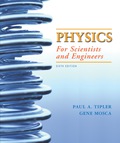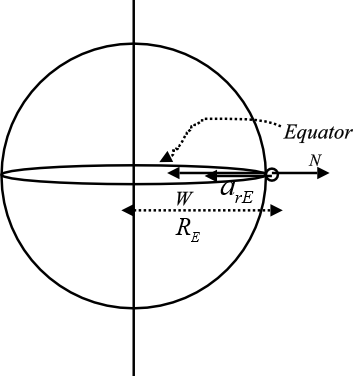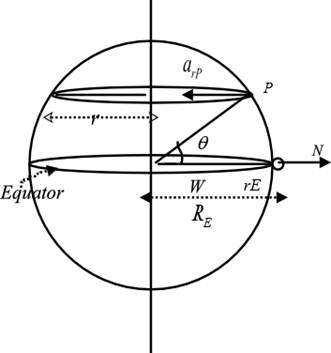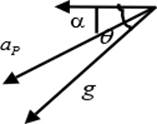
Concept explainers
(a)
The speed and magnitude of the acceleration of a person standing on the equator.
(a)
Answer to Problem 67P
A person standing on the equator has a speed
Explanation of Solution
Given:
Time taken by the Earth to rotate once on its axis,
Radius of the Earth,
Formula used:
The speed
The person on the equator experiences a centripetal acceleration
The total acceleration at the equator is given by,
Calculation:
A person standing on the equator, revolves in a circular path of radius
Calculate speed
All particles fixed on the Earth experience a centripetal force directed towards the center of its circular path. Hence it would experience a centripetal acceleration towards the center of its circular path.
Calculate the centripetal acceleration
Express the acceleration as a percentage of
The total acceleration experienced by the person is given by equation (3).
Conclusion:
Thus, a person standing on the equator has a speed
(b)
The direction of the acceleration vector of the person on the equator.
(b)
Answer to Problem 67P
The acceleration vector of the person is directed towards the center of the Earth.
Explanation of Solution
Introduction:
A person on the surface of the Earth experiences two forces-(i) Gravitational force
An object in order to move in a circular path requires

Figure 1
However, the weight, as felt by the person on the surface of the earth, is equal to the Normal force he experiences.
Hence, the acceleration
Conclusion:
Thus, the acceleration vector of the person on the Equator is directed towards the center of the Earth.
(c)
The speed and magnitude of the acceleration of a person standing at
(c)
Answer to Problem 67P
The speed of the person at
Explanation of Solution
Given:
The latitude where the person was standing,
Radius of the earth at equator,
The speed of the person at equator,
The centripetal acceleration at the equator,
Formula used:
The person at
The speed of person at
His speed at equator is given by
From equations (4) and (5),
The centripetal acceleration at the equator is given by the expression,
The centripetal acceleration at
From equations (4) and (5),
The person also experiences acceleration
The magnitude of the resultant acceleration is determined by using parallelogram law of vectors.
Calculation:
The motion of the person at

Figure 2
From Figure 2, it can be seen that
Use equation (11) in equation (6).
Substitute the value of the variables in the above equation.
Use equation (11) in equation (9) and substitute the values of the variables to calculate the value of
The vector
Substitute the values of variables in equation (10) and calculate the magnitude of the resultant acceleration
Conclusion:
Thus, the speed of the person at
(d)
The angle between the direction of the acceleration at
(d)
Answer to Problem 67P
The angle between the direction of the acceleration at
Explanation of Solution
Given:
The magnitude of centripetal acceleration at
The value of acceleration of free fall,
The latitude where the person was standing,
Formula used:
The direction of the acceleration at the equator is along the horizontal direction parallel to the direction of the centripetal acceleration at
Hence the angle
The vector diagram representing the accelerations is shown below:

Figure 3
This is given by
Calculation:
Substitute the values of the variables in equation (12).
Conclusion:
Thus, the angle between the direction of the acceleration at
Want to see more full solutions like this?
Chapter 3 Solutions
EBK PHYSICS FOR SCIENTISTS AND ENGINEER
- Which of the following is impossible for a car moving in a circular path? Assume that the car is never at rest. (a) The car has tangential acceleration but no centripetal acceleration. (b) The car has centripetal acceleration but no tangential acceleration. (c) The car has both centripetal acceleration and tangential acceleration.arrow_forwardIf the speed of an object in uniform circular motion is tripled and the radial distance remains constant then the magnitude of the centripetal acceleration increases by what factor?arrow_forwardA car starts from rest on a curve with a radius of 130 m and accelerates tangentially at 1.1 m/s2. Through what angle will the car have travelled when the magnitude of its total acceleration is 2.9 m/s2?arrow_forward
- Figure shows the total acceleration and velocity of a particle moving clockwise in a circle of radius 2.5 m at a given instant of time. At this instant, find: (a) the radial acceleration, (b) the speed of the particle and (c) its tangential acceleration.arrow_forwardA planet orbits a star, in a year of length 3.51 x 107 s, in a nearly circular orbit of radius 3.92 x 1011 m. With respect to the star, determine (a) the angular speed of the planet, (b) the tangential speed of the planet, and (c) the magnitude of the planet's centripetal acceleration.arrow_forwardIn the problems that follow, point P moves with angular velocity v on a circle of radius r.In each case, find the distance s traveled by the point in time t. v = 3 pi /2 rad/sec, r = 4 m, t = 30 secarrow_forward
- An experimental jet rocket travels around Earth along its equator just above its surface. At what speed must the jet travel if the magnitude of its acceleration is g?arrow_forwardThe earth has a radius of 6380 km and turns around once on its axis in 24h. a) What is the radial acceleration of an object on the ground at the earth’s equator? Give your answer in units of m/s and compare your result with the gravitational acceleration g. b) What is the radial acceleration of an object on the ground at the earth’s geographic North pole?arrow_forwardIf there is a net force on a particle in uniform circular motion, why doesn’t the particle’s speed change?arrow_forward
- Suppose an artificial satellite has been put into circular orbit about the Earth, at a distance from the center of the Earth equal to 1/4 the distance from the Earth's center to the Moon's center. In terms of the Moon's period Tm, what will be the period of the satellite?arrow_forwardStarting from a standstill, a windmill-style softball pitcher executed a pitch in 0.6 s. If her pitching arm is 0.75 m long and the tangential ball speed is 25 m/s, what is the magnitude of the total acceleration on the ball at this point?arrow_forward
 Principles of Physics: A Calculus-Based TextPhysicsISBN:9781133104261Author:Raymond A. Serway, John W. JewettPublisher:Cengage Learning
Principles of Physics: A Calculus-Based TextPhysicsISBN:9781133104261Author:Raymond A. Serway, John W. JewettPublisher:Cengage Learning
